 |
||
|
||
| ||
You are probably surprised at the name of this company and at the name of one of the cards... Triplex Corporation was founded in 1991. It was time of first attempts of users to assemble their own machines. At that time some companies were already producing separate components of computers such as video cards, mainboards etc. Of course, the retail market was also glutted with processors. In 1992 Triplex offered us the advanced for that time product from Treng Labs - ET3000, and then ET4000. Triplex promoted their products quite successfully (later its video cards were based on chips from S3, SIS and others) both on the OEM and Retail markets. However, this company is known (and very popular) mostly in China and in Taiwan. At present this company produces video cards based on processors from NVIDIA, SIS and PowerVR. Not so long ago Triplex announced a new product based on the SIS Xabre, - well, it marches in step with time. And today we will take a look at the cards based on the NVIDIA GPU. As I understood, the word GESTAPO came from the Chinese language and means something inoffensive. However, some mass media now ignore Triplex. As usual, first of all let's take a look at the reviews on GeForce4 Ti video cards published on our site. Theoretical materials and reviews of video cards which concern functional properties of the NVIDIA GeForce4 Ti GPU
Triplex differs from others not only in nonstandard video cards, but also in some unique solutions. In particular, the idea to cover a PCB with a thin silver layer has already taken root. Today almost all Triplex products are based on such PCBs. It gives two advantages:
The details will be spoken about further. Cards
As you can see, the Triplex Millenium Silver GeForce4 Ti 4600 card follows the reference design, but the other card (Ti 200) does not. However, the latter is based on the GeForce3' design (see the photo) and comes with the 3.8ns memory. It seems that we have a GeForce3 card under the guise of Ti 200. But if you take off the cooler you will see the GeForce3 Ti 200 chip: 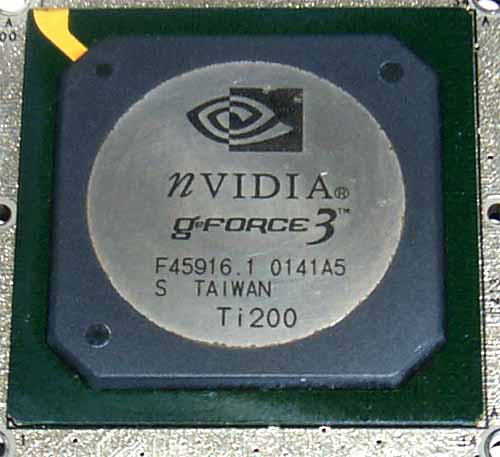 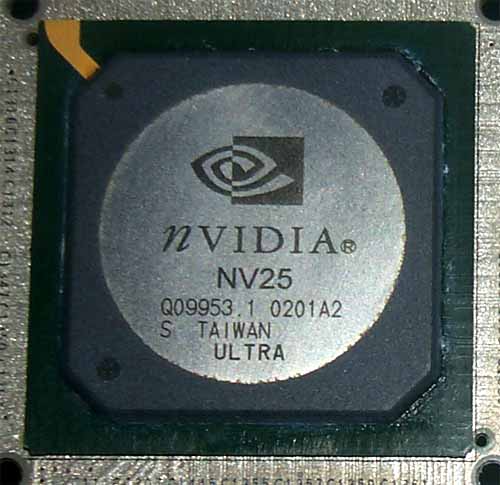 Below is a photo of the chip mounted on the Triplex Millenium Silver GeForce4 Ti 4600. As you can see, this sample comes with the A2 revision. However, I think that today all Ti 4600 cards are bundled with the A3 chips. Note that there is no difference in capabilities between the A2 and A3 revisions! The PCB is silvery - but it is not just color,
the card is really covered with a thin silver layer: Each element of the card is isolated from the silver sputtering, that is why there is nothing to worry about as far as the electric part is concerned. As I already mentioned, according to Triplex, the silver sputtering reduces the temperature of the video card by 10-15 degrees Celsius (but I didn't check it). The Triplex Millenium Silver GeForce4 Ti 4600 card
comes with the Philips 7108 codec supporting VIVO (Video-In Video-Out):
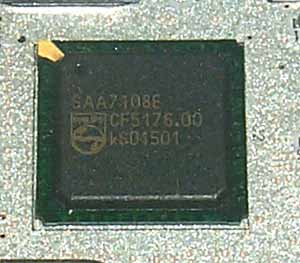 In the package you can find software from CyberLink which allows capturing video streams and creating video clips. The card has VGA and DVI connectors. The Triplex GESTAPO GeForce3 Ti 200 card has VGA, DVI and TV-out (S-Video) connectors. Now let me draw your attention to the cooling devices.
That's all what we had to say about peculiarities of these cards. Overclocking
While the Ti 4600 card has nothing to boast of, the Ti 200 easily outscores the GeForce3 Ti 500 in its potential. But I expected this because of the GeForce3's PCB and 3.8ns memory. Note:
Test system and driversThe card is supplied with the NVIDIA 27.30/WinXP and 27.20/Win9x drivers. However Triplex features some proprietary developments such as the card tuning tool: 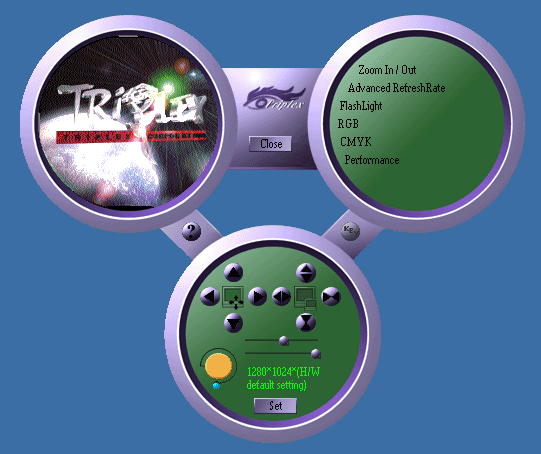 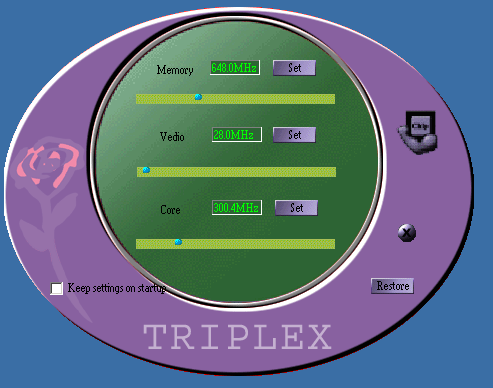 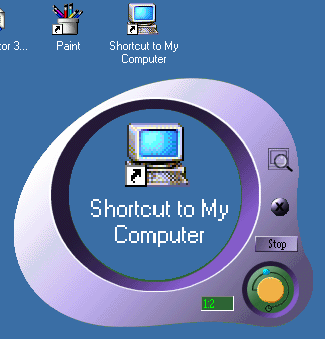 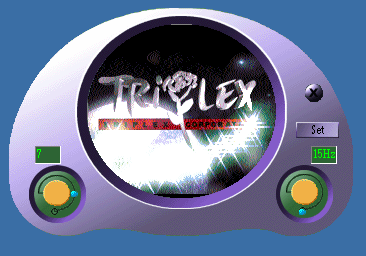 As you can see, the software not only enables to overclock the card and tune its 2D mode, but to modify overlay settings. There’s also the fun stuff - "lens" for magnifying desktop contents. Here we examine how the accelerator's performance depends on a CPU frequency (and on a platform), that is why we used several test stands:
The test system was coupled with ViewSonic P810 (21") and ViewSonic P817 (21") monitors. In the tests we used NVIDIA's drivers of v28.90. VSync was off, S3TC was off. For the comparative analyses we used the following cards:
Test results2D quality of the GeForce4 Ti 4600 card is very high; no problems in operation with the ViewSonic P817 monitor using the BNC cable. You can play comfortably at 1600x1200@85 Hz. Remember that 2D quality depends on a sample, on how a certain card gets along with a certain monitor. For estimation of 3D quality we used:
The test was carried out in a 32-bit color mode.I made two diagrams for each test grouping the results differently (for the processors and for the video cards/AA modes). These tests continue examination of quality and speed of anti-aliasing on different platforms and at different CPU frequencies. 3D Mark2001 SEGame3 Low DetailsAs the whole scene takes a room where light is almost lacking, it's difficult to show how the AA works. That is why there are no screenshots. 1024x768
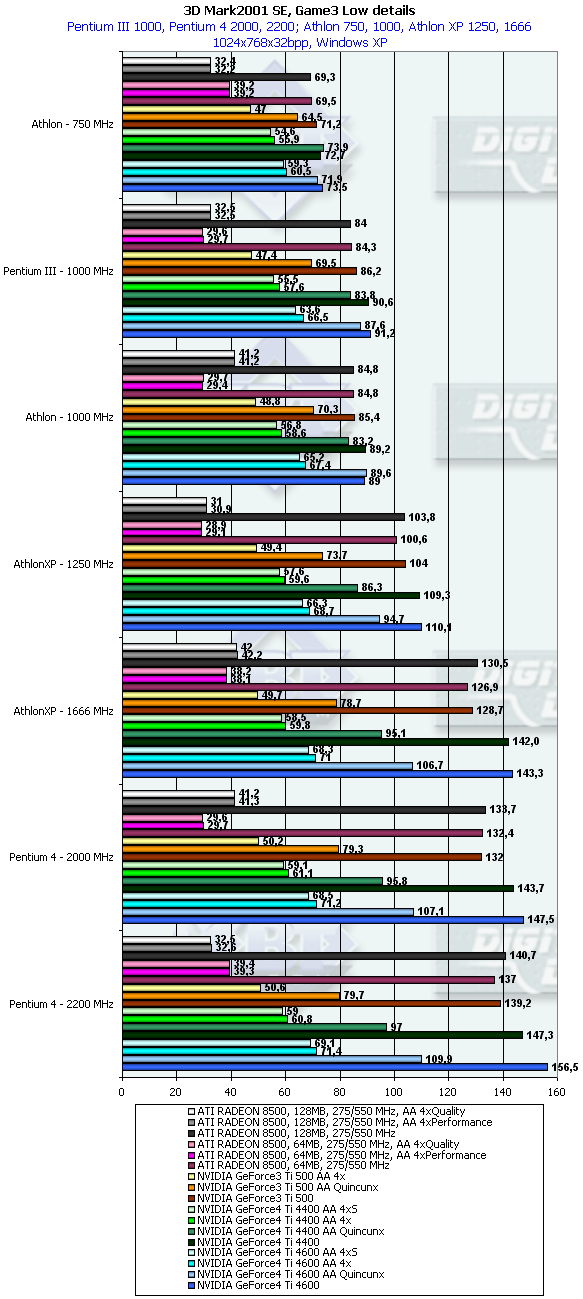
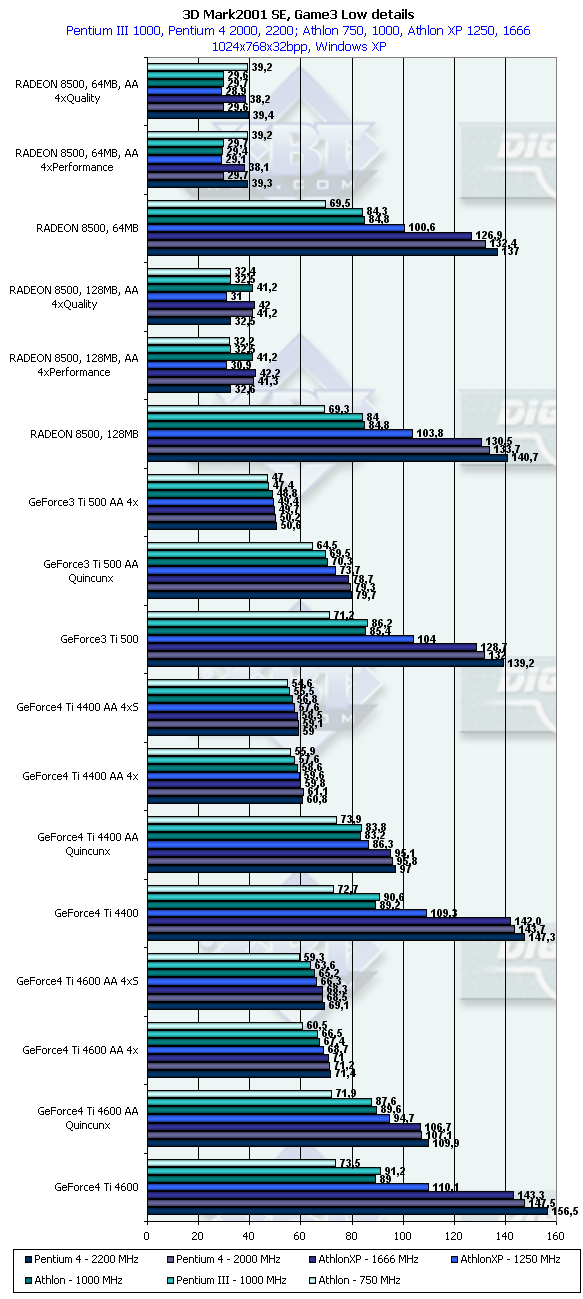 Note that we do not compare AA quality for the GeForce4 Ti and GeForce3 Ti 500 as it was done in the ABIT Siluro GF4 Ti review. I selected the 4x (Performance and Quality) mode of the SmoothVision (ATI) as it is the closest in quality to 4x and 4xS of NVIDIA, and it also provides acceptable speed and operability in 1024x768. But everything is relative. And this acceptable speed provides just the lowest playability for the RADEON 8500, because the performance decrease of these cards is great, on all processors and platforms. 1280x1024
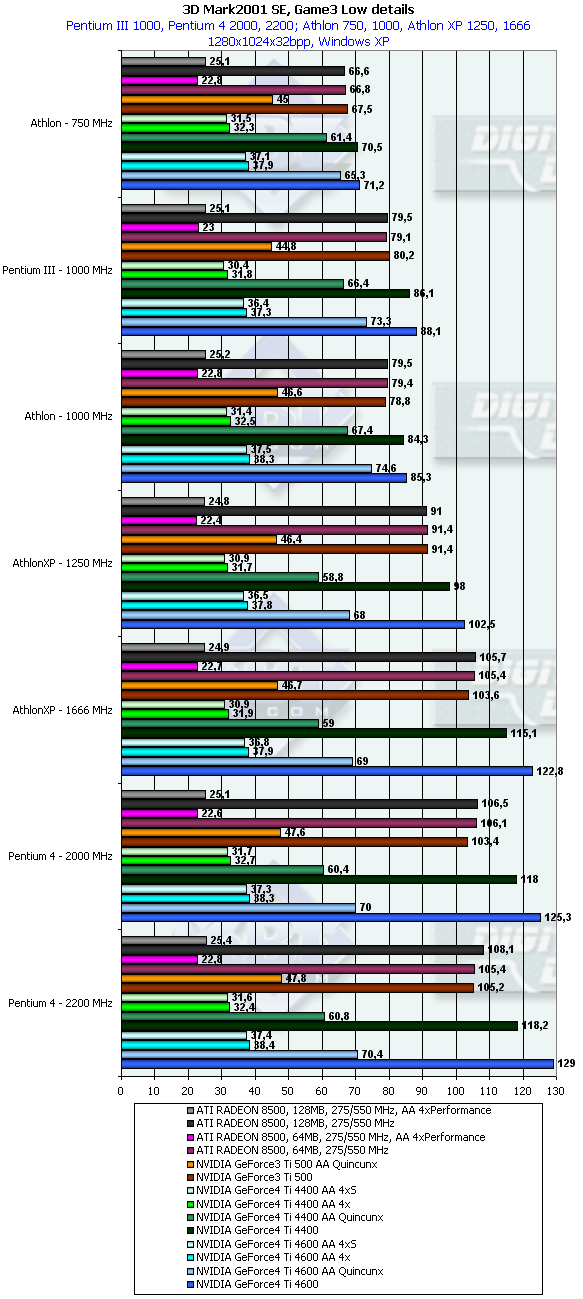
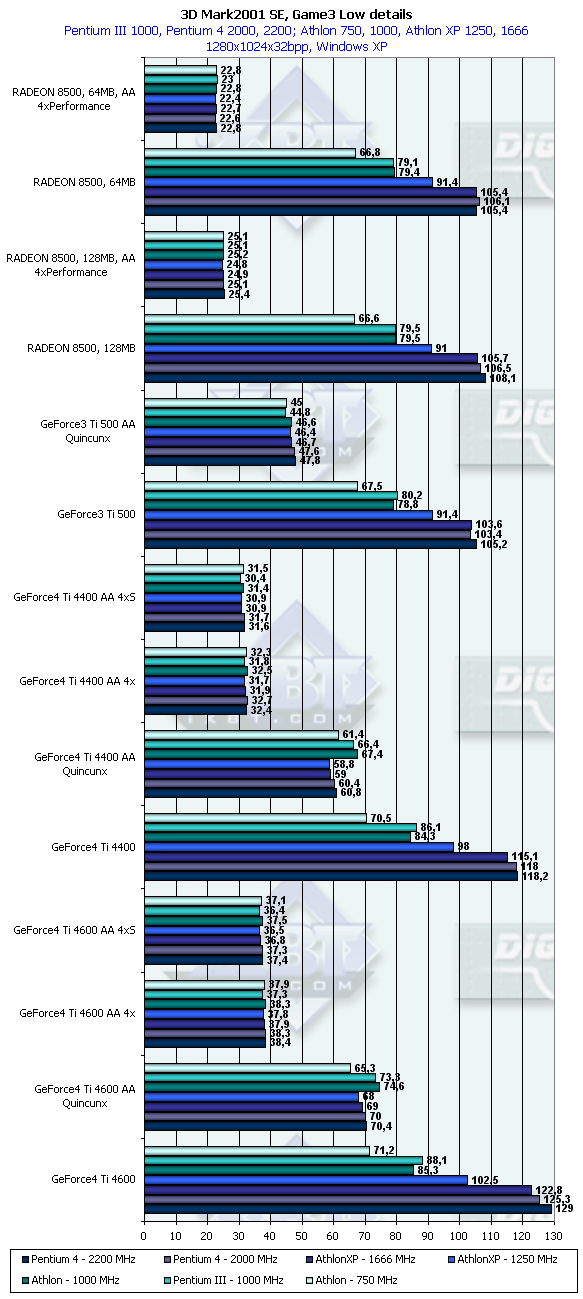 The situation is similar, even a little worse for the RADEON 8500. Game4
1024x768
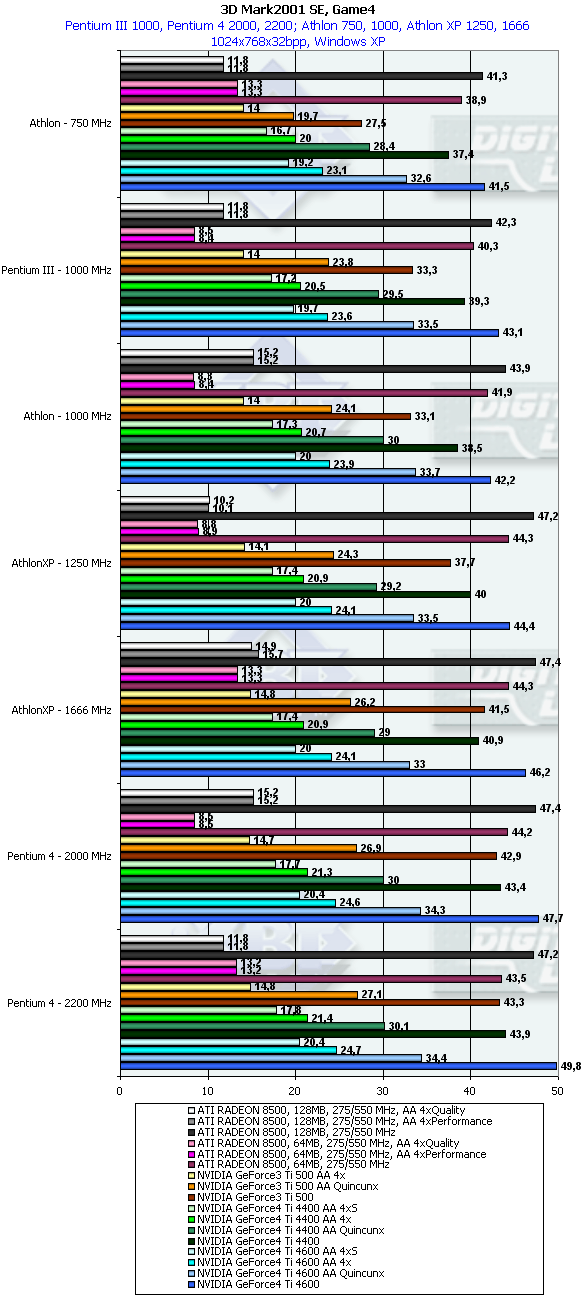
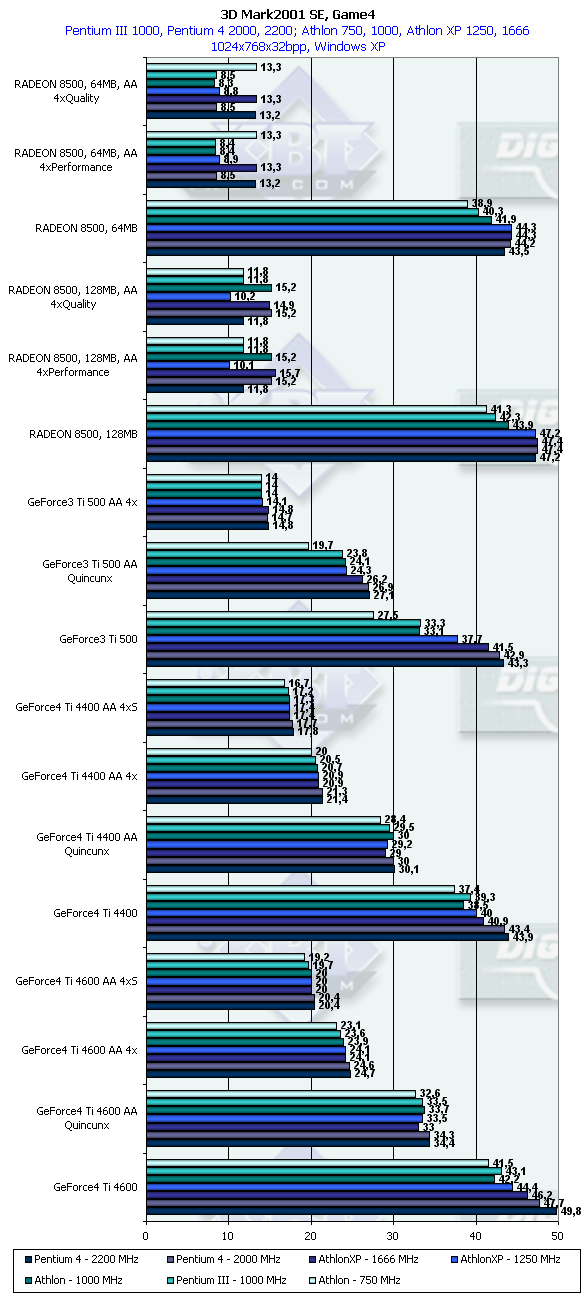 We can see that there is no AA on the leaves of the GeForce4 Ti because leaves are not independent objects, they are combined into "herbaria". And each herbarium is formed using transparent textures with which the MSAA doesn't work. That is why the RADEON 8500 smoothes the edges of the leaves, and the GeForce4 Ti does not. Besides, we can see that the RADEON 8500 128 MBytes performs much better than its 64 MBytes sister, though the results are still low. Note that quality of the AA 4xP of the ATI is better than that of the NVIDIA AA Quincunx. 1280x1024
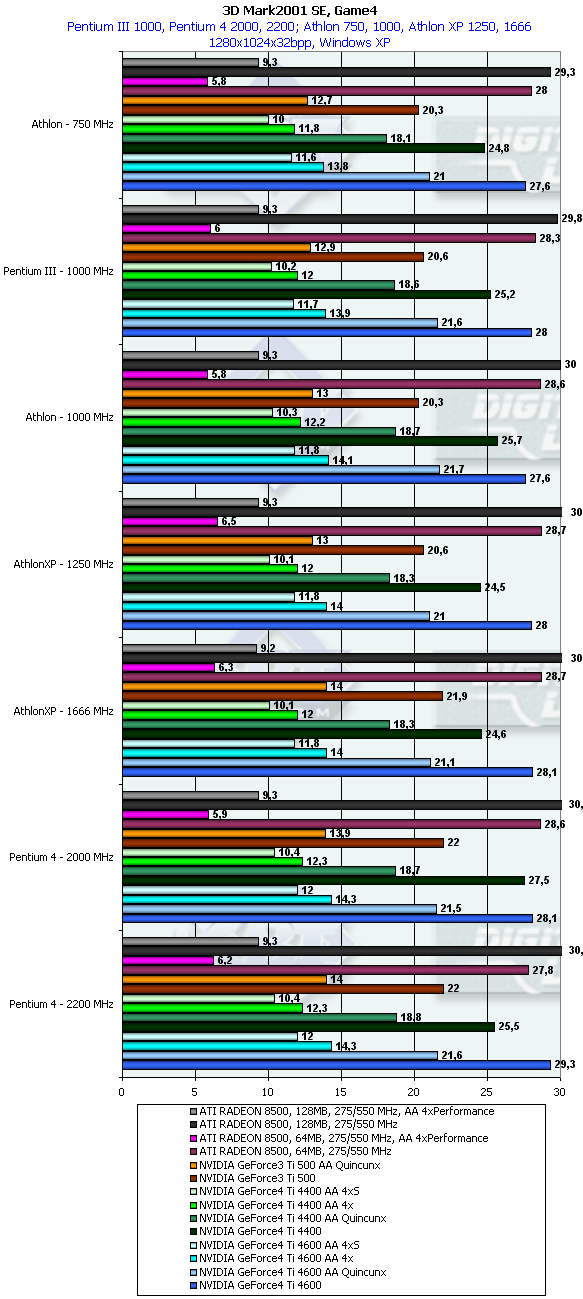
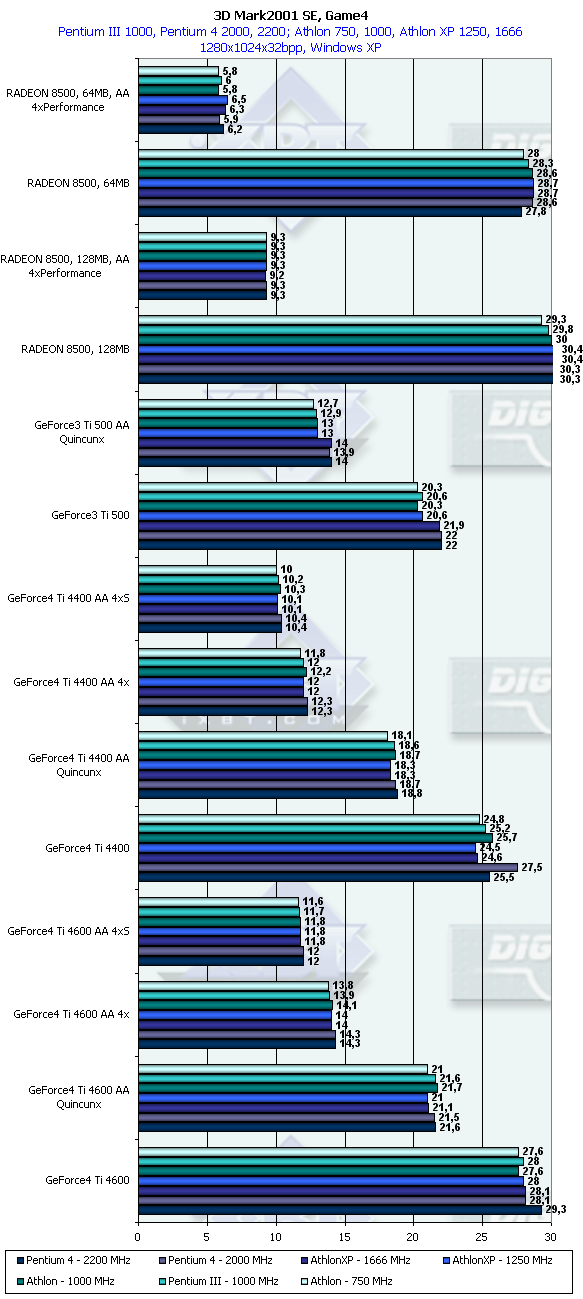 The situation is similar, it is just worse for the RADEON 8500. Note that 128 MBytes of the NVIDIA's cards let them activate AA's 4x mode in 1280x1024; but 128 MBytes of the RADEON 8500 doesn't help it with the AA 4xQ. Next time we will analyze AA and anisotropy together in the review of the ABIT's GeForce4 Ti 4600 card. It makes no sense to show diagrams with the results of the Triplex GESTAPO GeForce3 Ti 200 because the card performs at the level of its class. Performance of such cards on different platforms and in different tests can be found in our 3Digest. There you can also find a speed of operation of such cards overclocked up to 265/520 MHz. ConclusionWe have finished examination of operation of the AA in the 3DMark2001 on seven platforms. The results are obvious: the GeForce4 Ti is an insuperable leader, both in quality and in speed. As I mentioned before, the AA Quincunx quality of the GeForce4 Ti has increased as compared with the GeForce3 Ti. And now a little conclusion on the Triplex video cards. First of all, we got a real masterpiece in the High-End video game sector which is the Triplex Millenium Silver GeForce4 Ti 4600. By this I mean an excellent set of accessories shipping in a small suit case, a silver-covered PCB and high quality of the card. The price, however, is not striking: this card is not dearer than the similar ASUSTeK's cards (some $400). The Triplex GESTAPO GeForce3 Ti 200 is also a very interesting solution. Here we can also see a technology of pickups elimination and temperature reduction using silver sputtering; besides, the card is based on the GeForce3's design which improves its overclocking potential. The 3.8ns memory is just an advantage. The card costs approximately $130 (wholesale). For more complete characteristics of video cards of this and other classes see our 3Digest. Highs:
Lows:
Write a comment below. No registration needed!
|
Platform · Video · Multimedia · Mobile · Other || About us & Privacy policy · Twitter · Facebook Copyright © Byrds Research & Publishing, Ltd., 1997–2011. All rights reserved. | |||||||||||||||||||||||||||||||||||||||||||||||||||||||||||||||||||||||||||||